【問題】
【難易度】★★★★☆(やや難しい)
次の文章は,三相交流回路に関する記述である。文中の\( \ \fbox{$\hskip3em\Rule{0pt}{0.8em}{0em}$} \ \)に当てはまる最も適切なものを解答群の中から選びなさい。ただし,\( \ a \ \)は複素数で\( \ \displaystyle a=e^{\mathrm {j}\frac {2}{3}\pi} \ \)とする。
図1に示すように,対称三相交流電圧源にアドミタンスが\( \ {\dot Y}_{\mathrm {a}} \ \),\( \ {\dot Y}_{\mathrm {b}} \ \),\( \ {\dot Y}_{\mathrm {c}} \ \)の\( \ \mathrm {Y} \ \)形不平衡負荷を接続した。負荷と電源の中性点を結ぶ中性線のアドミタンスを\( \ {\dot Y}_{\mathrm {n}} \ \)とする。\( \ {\dot E}_{\mathrm {a}}=100 \ \mathrm {V}∠0° \ \)であり,相回転は\( \ {\dot E}_{\mathrm {a}} \ \),\( \ {\dot E}_{\mathrm {b}} \ \),\( \ {\dot E}_{\mathrm {c}} \ \)の順(\( \ {\dot E}_{\mathrm {b}}=a^{2}{\dot E}_{\mathrm {a}} \ \),\( \ {\dot E}_{\mathrm {c}}=a{\dot E}_{\mathrm {a}} \ \))とする。\( \ \mathrm {Y} \ \)形不平衡負荷のアドミタンス\( \ {\dot Y}_{\mathrm {a}} \ \),\( \ {\dot Y}_{\mathrm {b}} \ \),\( \ {\dot Y}_{\mathrm {c}} \ \)は以下の形とする。
\[
\left(
\begin{array}{c}
{\dot Y}_{\mathrm {a}} \\
{\dot Y}_{\mathrm {b}} \\
{\dot Y}_{\mathrm {c}}
\end{array}
\right)
=
\left(
\begin{array}{c}
{\dot Y}_{\mathrm {0}}+\Delta \dot Y \\
{\dot Y}_{\mathrm {0}}+a\Delta \dot Y \\
{\dot Y}_{\mathrm {0}}+a^{2}\Delta \dot Y
\end{array}
\right)
, \Delta \dot Y ≠ 0 ・・・・・・・ ①
\]
ここで,\( \ 1+a+a^{2}=0 \ \),\( \ a^{3}=1 \ \)に注意する。
ミルマンの定理と①式を使うと,\( \ \mathrm {Y} \ \)形負荷の中性点電位\( \ {\dot V}_{\mathrm {n}} \ \)と中性線電流\( \ {\dot I}_{\mathrm {n}} \ \)の式は,
\[
{\dot V}_{\mathrm {n}}= \ \fbox { (1) }, {\dot I}_{\mathrm {n}}= \ \fbox { (1) }\times {\dot Y}_{\mathrm {n}} ・・・・・・・・ ②
\]
となる。
図1の三相回路の中性点間を短絡又は開放したところ,以下の結果を得た。
(a) 中性点間を短絡すると(\( \ {\dot Y}_{\mathrm {n}}=\infty \ \)),中性点電流は\( \ {\dot I}_{\mathrm {n}}=30a \ \mathrm {[A]} \ \)となった。
(b) 中性点間を開放すると(\( \ {\dot Y}_{\mathrm {n}}=0 \ \)),\( \ \mathrm {Y} \ \)形負荷の中性点電位は\( \ {\dot V}_{\mathrm {n}}=100a \ \mathrm {[V]} \ \)となった。
②式に(a)と(b)の結果を適用すると,\( \ ({\dot Y}_{0},\Delta \dot Y)= \ \fbox { (2) } \ \mathrm {[S]} \ \)となる。
図1の回路を\( \ {\dot Y}_{\mathrm {n}} \ \)から見た等価回路を図2のように表すと,(a)及び(b)から\( \ {\dot Z}_{0}= \ \fbox { (3) } \ \Omega \ \)となる。したがって,図1の回路の中性線で消費する電力が最大となるのは\( \ {\dot Y}_{\mathrm {n}}= \ \fbox { (4) } \ \mathrm {S} \ \)のときである。そのとき,中性線で消費する電力は\( \ \fbox { (5) } \ \mathrm {W} \ \)である。

〔問5の解答群〕
\[
\begin{eqnarray}
&(イ)& 300 &(ロ)& \frac {10a}{3} &(ハ)& \frac {3a}{10} \\[ 5pt ]
&(ニ)& \frac {3{\dot E}_{\mathrm {a}}\Delta \dot Y}{{\dot Y}_{\mathrm {0}}+3{\dot Y}_{\mathrm {n}}} &(ホ)& \left( \frac {1}{10},\frac {a}{10}\right) &(ヘ)& 250 \\[ 5pt ]
&(ト)& \left( \frac {1}{10},\frac {1}{10}\right) &(チ)& \left( \frac {1}{10},\frac {a^{2}}{10}\right) &(リ)& \frac {10}{3} \\[ 5pt ]
&(ヌ)& 750 &(ル)& \frac {3a^{2}}{10} &(ヲ)& \frac {3{\dot E}_{\mathrm {a}}\Delta \dot Y}{3{\dot Y}_{\mathrm {0}}+{\dot Y}_{\mathrm {n}}} \\[ 5pt ]
&(ワ)& \frac {3}{10} &(カ)& \frac {10a^{2}}{3} &(ヨ)& \frac {3{\dot E}_{\mathrm {a}}{\dot Y}_{\mathrm {n}}}{3{\dot Y}_{\mathrm {0}}+\Delta \dot Y}
\end{eqnarray}
\]
【ワンポイント解説】
キルヒホッフの法則を用いても解くことは可能ですが,ミルマンの定理を理解していれば,幾分計算が楽になります。一種平成27年度理論問3の\( \ E_{0} \ \)の導出もミルマンの定理を用いて解くことが可能なので,本問が終わったら解いてみて下さい。
1.ミルマンの定理
図1に示すような並列回路があった時,電圧\( \ \dot V \ \)は,
\[
\dot V=\frac {\displaystyle \frac {{\dot E}_{1}}{{\dot Z}_{1}} +\frac {{\dot E}_{2}}{{\dot Z}_{2}}+ \cdots +\frac {{\dot E}_{\mathrm {n}}}{{\dot Z}_{\mathrm {n}}}}{\displaystyle \frac {1}{{\dot Z}_{1}} +\frac {1}{{\dot Z}_{2}}+ \cdots +\frac {1}{{\dot Z}_{\mathrm {n}}}}
\]
で求められます。
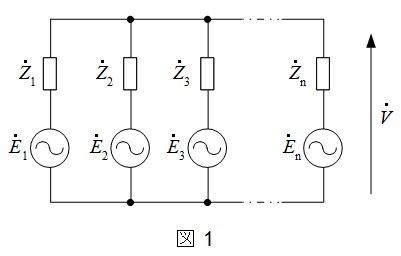
【関連する「電気の神髄」記事】
【解答】
(1)解答:ヲ
ワンポイント解説「1.ミルマンの定理」より中性点電位\( \ {\dot V}_{\mathrm {n}} \ \)は,
\[
\begin{eqnarray}
{\dot V}_{\mathrm {n}}&=&\frac {{\dot E}_{\mathrm {a}}{\dot Y}_{\mathrm {a}}+{\dot E}_{\mathrm {b}}{\dot Y}_{\mathrm {b}}+{\dot E}_{\mathrm {c}}{\dot Y}_{\mathrm {c}}}{{\dot Y}_{\mathrm {a}}+{\dot Y}_{\mathrm {b}}+{\dot Y}_{\mathrm {c}}+{\dot Y}_{\mathrm {n}}} \\[ 5pt ]
\end{eqnarray}
\]
となるので,\( \ {\dot E}_{\mathrm {b}}=a^{2}{\dot E}_{\mathrm {a}} \ \),\( \ {\dot E}_{\mathrm {c}}=a{\dot E}_{\mathrm {a}} \ \)及び①を代入すると,
\[
\begin{eqnarray}
{\dot V}_{\mathrm {n}}&=&\frac {{\dot E}_{\mathrm {a}}({\dot Y}_{\mathrm {0}}+\Delta \dot Y)+a^{2}{\dot E}_{\mathrm {a}}({\dot Y}_{\mathrm {0}}+a\Delta \dot Y)+a{\dot E}_{\mathrm {a}}({\dot Y}_{\mathrm {0}}+a^{2}\Delta \dot Y)}{{\dot Y}_{\mathrm {0}}+\Delta \dot Y+{\dot Y}_{\mathrm {0}}+a\Delta \dot Y+{\dot Y}_{\mathrm {0}}+a^{2}\Delta \dot Y+{\dot Y}_{\mathrm {n}}} \\[ 5pt ]
&=&\frac {\left( 1+a^{2}+a\right) {\dot E}_{\mathrm {a}}{\dot Y}_{\mathrm {0}}+3{\dot E}_{\mathrm {a}}\Delta \dot Y}{3{\dot Y}_{\mathrm {0}}+\left( 1+a^{2}+a\right) \Delta \dot Y+{\dot Y}_{\mathrm {n}}} \\[ 5pt ]
&=&\frac {3{\dot E}_{\mathrm {a}}\Delta \dot Y}{3{\dot Y}_{\mathrm {0}}+{\dot Y}_{\mathrm {n}}} \\[ 5pt ]
\end{eqnarray}
\]
と求められる。また,中性点電流\( \ {\dot I}_{\mathrm {n}} \ \)は,
\[
\begin{eqnarray}
{\dot I}_{\mathrm {n}}&=&{\dot V}_{\mathrm {n}}{\dot Y}_{\mathrm {n}} \\[ 5pt ]
&=&\frac {3{\dot E}_{\mathrm {a}}\Delta \dot Y}{3{\dot Y}_{\mathrm {0}}+{\dot Y}_{\mathrm {n}}}\times {\dot Y}_{\mathrm {n}} \\[ 5pt ]
\end{eqnarray}
\]
と求められる。
(2)解答:ホ
問題文(a)より,
\[
\begin{eqnarray}
\displaystyle \lim_{ {\dot Y}_{\mathrm {n}} \to \infty } {\dot I}_{\mathrm {n}}&=&30a \\[ 5pt ]
\displaystyle \lim_{ {\dot Y}_{\mathrm {n}} \to \infty } \left( \frac {3{\dot E}_{\mathrm {a}}\Delta \dot Y}{3{\dot Y}_{\mathrm {0}}+{\dot Y}_{\mathrm {n}}}\times {\dot Y}_{\mathrm {n}}\right) &=&30a \\[ 5pt ]
\displaystyle \lim_{ {\dot Y}_{\mathrm {n}} \to \infty } \left( \frac {3{\dot E}_{\mathrm {a}}\Delta \dot Y}{\frac {3{\dot Y}_{\mathrm {0}}}{{\dot Y}_{\mathrm {n}}}+1}\right) &=&30a \\[ 5pt ]
3{\dot E}_{\mathrm {a}}\Delta \dot Y&=&30a \\[ 5pt ]
3\times 100\Delta \dot Y&=&30a \\[ 5pt ]
\Delta \dot Y&=&\frac {a}{10} \\[ 5pt ]
\end{eqnarray}
\]
と求められる。また,(b)より,
\[
\begin{eqnarray}
\displaystyle \lim_{ {\dot Y}_{\mathrm {n}} \to 0 } {\dot V}_{\mathrm {n}}&=&100a \\[ 5pt ]
\displaystyle \lim_{ {\dot Y}_{\mathrm {n}} \to 0 } \left( \frac {3{\dot E}_{\mathrm {a}}\Delta \dot Y}{3{\dot Y}_{\mathrm {0}}+{\dot Y}_{\mathrm {n}}}\right) &=&100a \\[ 5pt ]
\frac {{\dot E}_{\mathrm {a}}\Delta \dot Y}{{\dot Y}_{\mathrm {0}}}&=&100a \\[ 5pt ]
\frac {\displaystyle 100\cdot \frac {a}{10}}{{\dot Y}_{\mathrm {0}}}&=&100a \\[ 5pt ]
{\dot Y}_{\mathrm {0}}&=&\frac {1}{10} \\[ 5pt ]
\end{eqnarray}
\]
と求められる。
(3)解答:リ
\( \ z_{0} \ \)は図1の回路を\( \ {\dot Y}_{\mathrm {n}} \ \)から見た時のインピーダンスであるから,
\[
\begin{eqnarray}
z_{0}&=&\frac {1}{{\dot Y}_{\mathrm {a}}+{\dot Y}_{\mathrm {b}}+{\dot Y}_{\mathrm {c}}} \\[ 5pt ]
&=&\frac {1}{3{\dot Y}_{0}} \\[ 5pt ]
&=&\frac {10}{3} \\[ 5pt ]
\end{eqnarray}
\]
と求められる。
(4)解答:ワ
中性線で消費する電力が最大となるのは,\( \ \displaystyle {\dot Y}_{\mathrm {n}}=\frac {1}{z_{0}} \ \)の時であるから,
\[
\begin{eqnarray}
{\dot Y}_{\mathrm {n}}&=&\frac {1}{z_{0}} \\[ 5pt ]
&=&\frac {3}{10} \\[ 5pt ]
\end{eqnarray}
\]
と求められる。
(5)解答:ヌ
中性線で消費する電力\( \ P_{\mathrm {n}} \ \)は,
\[
\begin{eqnarray}
P_{\mathrm {n}}&=&\left| {\dot V}_{\mathrm {n}}^{2}{\dot Y}_{\mathrm {n}}\right| \\[ 5pt ]
&=&\left| \left( 50a\right) ^{2}\times \frac {3}{10}\right| \\[ 5pt ]
&=&\left| 750a^{2} \right| \\[ 5pt ]
&=&750 \ \mathrm {[W]} \\[ 5pt ]
\end{eqnarray}
\]
と求められる。


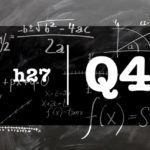


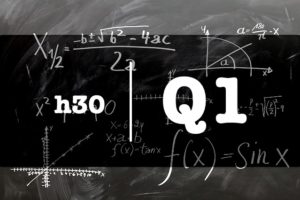

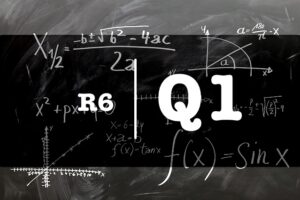


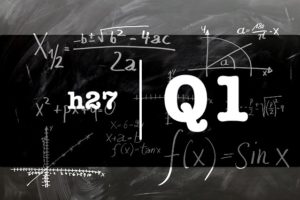











 愛知県出身 愛称たけちゃん
愛知県出身 愛称たけちゃん